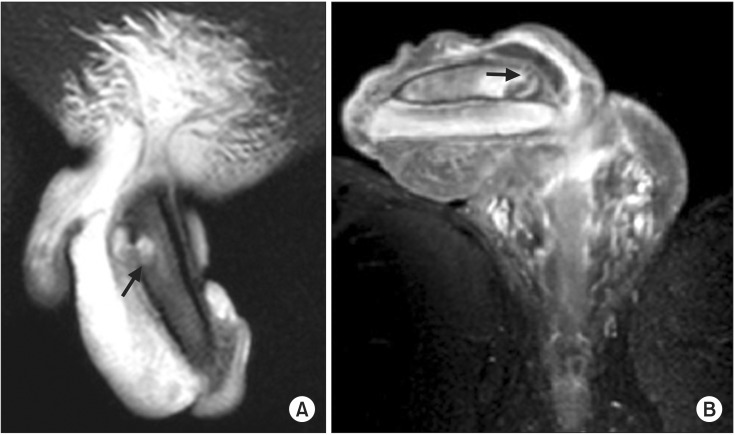Investig Clin Urol.
2017 Jul;58(4):255-260. 10.4111/icu.2017.58.4.255.
Efficacy of magnetic resonance imaging for diagnosis of penile fracture: A controlled study
- Affiliations
-
- 1Dr. Lütfi Kırdar Education and Research Hospital Urology Clinic, Istanbul, Turkey. erkinsaglam@hotmail.com
- 2Artvin State Hospital, Artvin, Turkey.
- KMID: 2410292
- DOI: http://doi.org/10.4111/icu.2017.58.4.255
Abstract
- PURPOSE
To evaluate the diagnostic value of magnetic resonance imaging (MRI) in patients with suspected penile fracture.
MATERIALS AND METHODS
A total of 122 patients admitted to our inpatient clinic with a suspicion of penile fracture following a recent history of penile trauma and who underwent surgical exploration were included this study. A thorough physical examination, a detailed medical history, description of the trauma, and preoperative International Index of Erectile Function (IIEF) scores were obtained for each patient prior to surgery. Thirty-eight of these patients were evaluated with MRI before the surgical exploration. Intraoperative findings were also recorded. Physical findings and IIEF scores were also recorded at postoperative 6 months.
RESULTS
The mean age of our patient group was 36.5±12.3 years. Penile fracture was detected in 105 of 122 patients in whom surgical exploration was performed owing to a suspected diagnosis. The mean time interval from penile trauma to hospital admittance was 9.9±15.1 hours. No cavernosal defect was detected in 9 of 84 patients (10.7%) who were not evaluated with MRI prior to surgery. Compared with surgical exploration, MRI findings showed 100% (30 of 30) sensitivity and 87.5% (7 of 8) specificity in the diagnosis of penile fracture. MRI had a high negative predictive value of 100% (7 of 7) and a positive predictive value of 96.7% (30 of 31) with just 1 misdiagnosed patient.
CONCLUSIONS
MRI is a reliable diagnostic tool in the diagnosis of penile fractures. Compared to history and physical findings taken all together, the high sensitivity and specificity of this imaging technique can decrease the number of unnecessary surgical explorations.
Keyword
MeSH Terms
Figure
Reference
-
1. Morey AF, Dugi DD. Genital and lower urinary tract trauma. In : Wein AJ, Kavoussi LR, Novick AC, Partin AW, Peters CA, editors. Campbell-Walsh urology. 10th ed. Philadelphia: Saunders;2012. p. 2379–2392.2. Koifman L, Barros R, Júnior RA, Cavalcanti AG, Favorito LA. Penile fracture: diagnosis, treatment and outcomes of 150 patients. Urology. 2010; 76:1488–1492. PMID: 20708223.
Article3. Antonini G, Vicini P, Sansalone S, Garaffa G, Vitarelli A, De Berardinis E, et al. Penile fracture: penoscrotal approach with degloving of penis after Magnetic Resonance Imaging (MRI). Arch Ital Urol Androl. 2014; 86:39–40. PMID: 24704930.
Article5. Zargooshi J. Sexual function and tunica albuginea wound healing following penile fracture: an 18-year follow-up study of 352 patients from Kermanshah, Iran. J Sex Med. 2009; 6:1141–1150. PMID: 19138357.
Article6. Asgari MA, Hosseini SY, Safarinejad MR, Samadzadeh B, Bardideh AR. Penile fractures: evaluation, therapeutic approaches and long-term results. J Urol. 1996; 155:148–149. PMID: 7490817.
Article7. Cummings JM, Parra RO, Boullier JA. Delayed repair of penile fracture. J Trauma. 1998; 45:153–154. PMID: 9680030.
Article8. el-Assmy A, el-Tholoth HS, Mohsen T, Ibrahiem el-HI. Does timing of presentation of penile fracture affect outcome of surgical intervention? Urology. 2011; 77:1388–1391. PMID: 21440289.
Article9. Swanson DE, Polackwich AS, Helfand BT, Masson P, Hwong J, Dugi DD 3rd, et al. Penile fracture: outcomes of early surgical intervention. Urology. 2014; 84:1117–1121. PMID: 25443914.
Article10. Ozcan S, Akpinar E. Diagnosis of penile fracture in primary care: a case report. Cases J. 2009; 2:8065. PMID: 19830047.
Article11. Srinivas BV, Vasan SS, Mohammed S. A case of penile fracture at the crura of the penis without urethral involvement: rare entity. Indian J Urol. 2012; 28:335–337. PMID: 23204666.
Article12. Dever DP, Saraf PG, Catanese RP, Feinstein MJ, Davis RS. Penile fracture: operative management and cavernosography. Urology. 1983; 22:394–396. PMID: 6636395.
Article13. Kachewar S, Kulkarni D. Ultrasound evaluation of penile fractures. Biomed Imaging Interv J. 2011; 7:e27. PMID: 22279504.14. Mazaris EM, Livadas K, Chalikopoulos D, Bisas A, Deliveliotis C, Skolarikos A. Penile fractures: immediate surgical approach with a midline ventral incision. BJU Int. 2009; 104:520–523. PMID: 19239439.
Article15. Lee SH, Bak CW, Choi MH, Lee HS, Lee MS, Yoon SJ. Trauma to male genital organs: a 10-year review of 156 patients, including 118 treated by surgery. BJU Int. 2008; 101:211–215. PMID: 17922859.
Article16. Koga S, Saito Y, Arakaki Y, Nakamura N, Matsuoka M, Saita H, et al. Sonography in fracture of the penis. Br J Urol. 1993; 72:228–229. PMID: 8402028.
Article17. Yokogi H, Mizutami M, Ishibe T. Magnetic resonance imaging of a penile fracture. Acta Urol Belg. 1992; 60:93–95. PMID: 1414726.
- Full Text Links
- Actions
-
Cited
- CITED
-
- Close
- Share
- Similar articles
-
- The Value of Magnetic Resonance Imaging in the Diagnosis of Penile Fracture
- US and MRI Findings of Penile Metastasis from Rectal Adenocarcinoma: A Case Report
- Penile Fracture: 2 Cases
- Magnetic Resonance Imaging Findings of Periosteal Interposition in a Distal Tibial Salter-Harris Type I Fracture with Surgical Correlation: A Case Report
- Ultrafast Magnetic Resonance Imaging: Echo Planar Imaging and Spiral Scan Imaging


